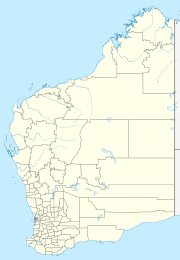Bunjil, Western Australia facts for kids
Quick facts for kids BunjilWestern Australia |
|
|---|---|
| Established | 1914 |
| Postcode(s) | 6623 |
| Elevation | 319 m (1,047 ft) |
| Area | [convert: needs a number] |
| Location |
|
| LGA(s) | Shire of Perenjori |
| State electorate(s) | Moore |
| Federal Division(s) | Durack |
Bunjil is a small town in Western Australia. It is located about 326 kilometers (202 miles) north of Perth. You can find it in the Mid West region of the state. In 2021, a census showed that 61 people lived there.
Contents
Exploring Bunjil's Past
Bunjil became an official town in 1914. Before that, it started as a railway siding in 1913. A railway siding is like a short extra track next to the main railway line. It was used to load and unload crops and farm animals. This helped farmers send their goods to other places.
What Does the Name Bunjil Mean?
The name Bunjil comes from Indigenous Australian languages. However, its exact meaning is not known today. Many places in Australia have names from the original Aboriginal inhabitants.
Bunjil's Role in Wheat Farming
In 1932, an important group called the Wheat Pool of Western Australia made an announcement. They said that Bunjil would get two special buildings called grain elevators. These elevators were built at the railway siding. Grain elevators are tall structures used to store large amounts of grain, like wheat. They also have machines to lift the grain up and down. This made it easier for farmers to store and transport their crops.
Life and Industry in Bunjil
The main activity in Bunjil is wheat farming. The town is a key location for farmers in the area.
How Wheat Gets Handled in Bunjil
Bunjil is a Cooperative Bulk Handling (CBH) receival site. This means it's a place where farmers bring their harvested wheat. CBH is a large company that helps farmers store and move their grain. They collect the wheat from many farms. Then, they prepare it for transport to other parts of Australia or even overseas. This makes Bunjil an important part of Western Australia's farming industry.


